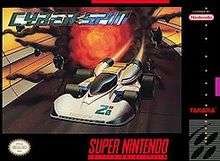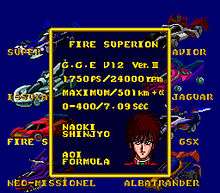Cyber Spin
Cyber Spin is a futuristic racing video game that was released in 1992 to Japan and North America for the Super NES. It is known in Japan as Shinseiki GPX: Cyber Formula (新世紀GPXサイバーフォーミュラ, New Century GPX Saiba Fomyura, "New Century GPX Cyber Formula")[4] which is based on the anime Future GPX Cyber Formula, and because of that, it has the proper license to use the characters from the anime.
| Cyber Spin | |
|---|---|
 North American cover art | |
| Developer(s) | Arc System Works[1] |
| Publisher(s) | |
| Designer(s) | Masako Araki[3] Keiko Kayajima[3] |
| Composer(s) | Junya Kozakai |
| Platform(s) | Super NES[2] |
| Release | |
| Genre(s) | Racing[2] |
| Mode(s) | Single-player |
Gameplay
The game uses a top-down perspective and was designed in the same technique as classic arcade racing games.[5] The vehicles of the two versions are completely different from each other. There are tracks all around the world.[5] Players of the game become a part of a science-fiction version of the 2015 Formula One season. All of the automobiles are turbocharged with advanced futuristic technology that allows for extra speed every time a "Power Boost" is used (at the cost of the vehicle's energy reserves).[1] In the Japanese version, the fastest car (Super Asurada 01) can travel up to 512 kilometres per hour (318 mph).

The player does not automatically qualify for a race and must beat a certain time limit to advance the story line. There is a free mode and a GPX mode (Japanese release only), password mode and scenario mode (with Japanese anime-like cut scenes in the Japanese version). Passwords consisting of letters and numbers helps the player keep their progress in the game.[1] In the scenario mode, the object is to guide an up-and-coming driver to the ultimate victory. Quitting once means game over. There is a different order of race tracks that the player confronts when comparing the Japanese version to the North American version. For example, the tracks in the earlier stages of the North American version are quite simple while the Japanese version forces the player to compete against more "complex" race layouts starting from the second level.
Reception
Allgame gave this video game a score of 3 stars out of a possible 5.[6]
See also
References
- "Miscellaneous information". GameSpy. Archived from the original on 2008-09-05. Retrieved 2009-07-28.
- "Release information #1". GameFAQs. Retrieved 2008-04-29.
- "Designer information". MobyGames. Retrieved 2011-12-27.
- "Release information #2". superfamicom.org. Retrieved 2008-04-29.
- "General features". IGN. Retrieved 2008-10-22.
- "Rating information". allgame. Retrieved 2012-10-07.
External links
- Japanese title at super-famicom.jp (in Japanese)